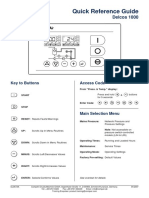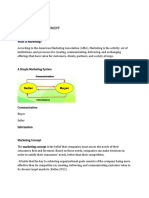Thu Ta - Assignment 3
Thu Ta - Assignment 3
Uploaded by
tatathu173Copyright:
Available Formats
Thu Ta - Assignment 3
Thu Ta - Assignment 3
Uploaded by
tatathu173Copyright
Available Formats
Share this document
Did you find this document useful?
Is this content inappropriate?
Copyright:
Available Formats
Thu Ta - Assignment 3
Thu Ta - Assignment 3
Uploaded by
tatathu173Copyright:
Available Formats
Tạ Thị Anh Thư MBAIU23037
ASSIGNMENT 3
CHAPTER 4
Question 1: What steps are involved in conducting good marketing research?
The marketing research process consists of defining
the problem, decision alternatives, and research
objectives; developing the research plan; collecting
the information; analyzing the information;
presenting the findings to management; and making
the decision.
1. Defining the Research Problem:
Clearly identify the specific question or issue
you want to address.
Determine the objectives of the research and
what you hope to achieve.
2. Developing a Research Design:
Choose the appropriate research methodology
(e.g., surveys, interviews, focus groups,
observation).
Determine the data collection methods and
sampling techniques.
Create a research questionnaire or interview
guide.
3. Collecting Data:
Gather data using the chosen methods.
Ensure data accuracy and reliability.
4. Analyzing Data:
Organize and analyze the collected data using statistical techniques or
qualitative analysis.
Look for patterns, trends, and insights.
5. Interpreting Findings:
Draw conclusions based on the data analysis.
Relate the findings to the research objectives.
6. Preparing the Research Report:
Organize the findings into a clear and concise report.
Include recommendations based on the research results.
By following these steps, businesses can conduct marketing research that yields
valuable insights and drives informed decision-making.
Question 2: What are the best metrics for measuring marketing productivity?
Marketers employ a wide variety of measures to assess marketing effects.
Marketing metrics is the set of measures that helps marketers quantify, compare,
and interpret their performance. Two complementary approaches to measuring
marketing productivity are: (1) marketing metrics to assess marketing effects and
(2) marketing-mix modeling to estimate causal relationships and measure how
marketing activity affects outcomes. Here are some key metrics to consider:
Overall Performance Metrics
Return on Marketing Investment (ROMI): This is a comprehensive metri
c that measures the net profit generated from marketing activities relative to
the marketing expenses.
Market Share: The percentage of a market that a company controls.
Customer Acquisition Cost (CAC): The average cost of acquiring a new c
ustomer.
Customer Lifetime Value (CLTV): The estimated total revenue a customer
will generate over their lifetime.
Brand Awareness and Engagement Metrics
Brand Recognition: The percentage of people who recognize and recall a br
and.
Brand Awareness: The level of familiarity and understanding of a brand.
Brand Loyalty: The extent to which customers are committed to a brand an
d prefer it over competitors.
Social Media Engagement: Metrics like likes, shares, comments, and follo
wers on social media platforms.
Website Traffic: The number of visitors to a company's website and their e
ngagement on the site.
Campaign-Specific Metrics
Click-Through Rate (CTR): The percentage of people who click on an ad
or link.
Conversion Rate: The percentage of website visitors who take a desired acti
on (e.g., making a purchase, signing up for a newsletter).
Cost Per Acquisition (CPA): The cost of acquiring a new customer through
a specific marketing channel.
Return on Ad Spend (ROAS): The revenue generated from advertising exp
enses.
Customer Satisfaction Metrics
Customer Satisfaction Surveys: Gather feedback on customer experiences
and satisfaction levels.
Net Promoter Score (NPS): Measure customer loyalty and willingness to re
commend a brand.
Customer Churn Rate: The percentage of customers who stop doing busin
ess with a company.
Additional Considerations
Industry Benchmarks: Compare your metrics to industry benchmarks to as
sess performance.
Data Quality: Ensure that data is accurate, consistent, and reliable.
Attribution Modeling: Determine how to attribute conversions to different
marketing channels.
Long-Term Perspective: Consider both short-term and long-term impacts o
f marketing efforts.
By tracking and analyzing these metrics, businesses can gain valuable insights into
the effectiveness of their marketing strategies and make data-driven decisions to
improve performance.
You might also like
- Quick Reference Guide: Delcos 1000Document2 pagesQuick Reference Guide: Delcos 1000Vijačni kompresori- Prodaja i servis65% (20)
- G12 ABM Business Enterprise Simulation Lesson 2Document11 pagesG12 ABM Business Enterprise Simulation Lesson 2Leo Suing100% (2)
- AX MIB Ref v261 GR1 P6 20130213 PDFDocument149 pagesAX MIB Ref v261 GR1 P6 20130213 PDFstephen virmwareNo ratings yet
- MarketResearchDocument8 pagesMarketResearchPriyanka ThakurelNo ratings yet
- Industrial MarketingDocument20 pagesIndustrial MarketingUtsav PatelNo ratings yet
- Chapter 2 - Marketing ResearchDocument19 pagesChapter 2 - Marketing ResearchMelanie Laureano100% (1)
- Advertising Research IntroDocument34 pagesAdvertising Research IntrodiamondtaiNo ratings yet
- Bus002 NotesDocument65 pagesBus002 NotesAdrianne Mae Almalvez RodrigoNo ratings yet
- Market ResearchDocument7 pagesMarket ResearchAzhar DkNo ratings yet
- Marketing Research Management, Unit-2Document3 pagesMarketing Research Management, Unit-2aakarshkapoor81No ratings yet
- MRM U5 PartcDocument19 pagesMRM U5 Partchimuna2102No ratings yet
- MR Chapter 1&2Document16 pagesMR Chapter 1&2Harshit JoshiNo ratings yet
- Unit-V: Marketing Information SystemDocument16 pagesUnit-V: Marketing Information SystemLords PorseenaNo ratings yet
- Chapter1 - Introduction To Marketing ResearchDocument34 pagesChapter1 - Introduction To Marketing ResearchAhmed KhalafNo ratings yet
- Chapter 1Document31 pagesChapter 1ahmedgalalabdalbaath2003No ratings yet
- Market Research ResumeDocument4 pagesMarket Research ResumeUnicorn ProjectNo ratings yet
- MM - Chapter 4Document19 pagesMM - Chapter 4thiennguyencongviec123No ratings yet
- Marketing Research ProcessDocument22 pagesMarketing Research ProcessJasjot BindraNo ratings yet
- Define What Market Research Is and How It Is UsedDocument6 pagesDefine What Market Research Is and How It Is Usedmrrpb459954No ratings yet
- Marketng Research: Richard D. Crisp Explains It As: Marketing Research Is The SystematicDocument20 pagesMarketng Research: Richard D. Crisp Explains It As: Marketing Research Is The SystematicDilip YadavNo ratings yet
- Chapter 9Document24 pagesChapter 9Eng Abdulkadir Mahamed100% (1)
- Marketing ResearchDocument29 pagesMarketing Researchmurudkaraditya110No ratings yet
- Ven ( - ́ - ̀ ) J (Prim)Document5 pagesVen ( - ́ - ̀ ) J (Prim)Yoxi ZerunNo ratings yet
- Market ResearchDocument9 pagesMarket ResearchAnkit G SinghNo ratings yet
- Strategic FomulationDocument4 pagesStrategic FomulationMia Glenn B. ZarsuelaNo ratings yet
- Marketing Research (Nature and Scope)Document9 pagesMarketing Research (Nature and Scope)Shrishti MathurNo ratings yet
- CB & MR UNIT-III NOTESDocument18 pagesCB & MR UNIT-III NOTESa66422603No ratings yet
- G12 Principles of Marketing W8 LASDocument14 pagesG12 Principles of Marketing W8 LASmaribeldevera razonableNo ratings yet
- Special 8 15Document3 pagesSpecial 8 15Isiah Ruiz NotarteNo ratings yet
- Quarter 3 Week 5 Business MarketingDocument31 pagesQuarter 3 Week 5 Business MarketingEKIMISS PHNo ratings yet
- Marketing ResearchDocument21 pagesMarketing ResearchAdityaNo ratings yet
- MM 01 Handout 5 Marketing ResearchDocument12 pagesMM 01 Handout 5 Marketing ResearchAsset DyNo ratings yet
- Topic 1-Intro To Mktg. ResearchDocument15 pagesTopic 1-Intro To Mktg. Researchlluv3774No ratings yet
- Marketing Research 1-5 ChaptersDocument29 pagesMarketing Research 1-5 Chaptersprice_na123No ratings yet
- Marketing Research CH 1Document16 pagesMarketing Research CH 1Dalia ElarabyNo ratings yet
- Why Is Advertising Research Important?Document7 pagesWhy Is Advertising Research Important?Faisal AhmedNo ratings yet
- IED RAM Module 4Document17 pagesIED RAM Module 4Jagyandutta NaikNo ratings yet
- Chapter 1 Role of Marketing ResearchDocument10 pagesChapter 1 Role of Marketing ResearchJohn Robert JavierNo ratings yet
- CHAPTER 2 Marketing ManagementDocument8 pagesCHAPTER 2 Marketing ManagementRuby De GranoNo ratings yet
- Conducting Marketing Research and Forecasting Demand: Learning ObjectivesDocument12 pagesConducting Marketing Research and Forecasting Demand: Learning Objectivessamer iqbalNo ratings yet
- Chapter 5 (1) - 1Document5 pagesChapter 5 (1) - 1Bare SharmakeNo ratings yet
- Research ProcessDocument6 pagesResearch Processmatheesha3601No ratings yet
- Marketing in Tourism-Module 2Document49 pagesMarketing in Tourism-Module 2Amanda ClarkeNo ratings yet
- Edited Market Research and ApplicationDocument17 pagesEdited Market Research and ApplicationkinjangmeritbihNo ratings yet
- Chapter 4 Conducting Marketing ResearchDocument22 pagesChapter 4 Conducting Marketing ResearchHeba SamiNo ratings yet
- AMM-Marketing Research (Assignment)Document5 pagesAMM-Marketing Research (Assignment)PRATIKSHA KARNo ratings yet
- 562 Naoroj Muntashir MM SlidesDocument33 pages562 Naoroj Muntashir MM SlidesAndy DropshipperNo ratings yet
- UNIT-1:) Definition of Strategic Marketing ManagementDocument20 pagesUNIT-1:) Definition of Strategic Marketing ManagementnaveenNo ratings yet
- Chapter 3Document27 pagesChapter 3Phương NguyễnNo ratings yet
- Mba MM303Document89 pagesMba MM303Shatasree MazumdarNo ratings yet
- Marketing Information SystemDocument36 pagesMarketing Information SystemMalik MohamedNo ratings yet
- Marketing Is The ActivityDocument17 pagesMarketing Is The ActivityJhon BalistoyNo ratings yet
- Market ResearchDocument7 pagesMarket ResearchTrifan_DumitruNo ratings yet
- Special FinalsDocument3 pagesSpecial FinalsIsiah Ruiz NotarteNo ratings yet
- Chapter 3 MARMADocument9 pagesChapter 3 MARMAbrodyNo ratings yet
- Chapter 4Document11 pagesChapter 4Christian SawayaNo ratings yet
- Marketing Research (Cruz, Jhazmine)Document4 pagesMarketing Research (Cruz, Jhazmine)cruzjhazminetrinidadNo ratings yet
- RM4Mgmt - Unit 2 - MOP - 2024Document19 pagesRM4Mgmt - Unit 2 - MOP - 2024drvkjk2023No ratings yet
- PDF PRINCIPLE-OF-MARKETING-WEEK-7-8Document15 pagesPDF PRINCIPLE-OF-MARKETING-WEEK-7-8Angelito AdoptanteNo ratings yet
- Marketing Research NotesDocument15 pagesMarketing Research NotesAntony MwangiNo ratings yet
- L MM Chapter 04,011010Document65 pagesL MM Chapter 04,011010trinhht22No ratings yet
- Chapter # 6 Consumer BehaviorDocument20 pagesChapter # 6 Consumer Behaviortatathu173No ratings yet
- Chapter # 1 Introduction-đã gộpDocument60 pagesChapter # 1 Introduction-đã gộptatathu173No ratings yet
- Chapter # 2 StrategiesDocument10 pagesChapter # 2 Strategiestatathu173No ratings yet
- Chapter # 1 IntroductionDocument10 pagesChapter # 1 Introductiontatathu173No ratings yet
- Ca. 290 KG Ca. 251 KG: Access and Connections As Drawed Measures in MM (Millimeters)Document6 pagesCa. 290 KG Ca. 251 KG: Access and Connections As Drawed Measures in MM (Millimeters)AI ChmNo ratings yet
- Development of QR-code Based Interactive Dynamic Billboard System With Motion DetectionDocument10 pagesDevelopment of QR-code Based Interactive Dynamic Billboard System With Motion DetectionEditor IjasreNo ratings yet
- Harikrishna GorantlaDocument4 pagesHarikrishna Gorantlasandeep NalluriNo ratings yet
- Autonomie - Training - Part3aDocument17 pagesAutonomie - Training - Part3amuradbashirNo ratings yet
- ACS550-01-03A3-4: General Purpose Drive Module, ACS550Document3 pagesACS550-01-03A3-4: General Purpose Drive Module, ACS550luis fernandoNo ratings yet
- Germans & Hungarians: 1828 Land Census, Vol. 04Document151 pagesGermans & Hungarians: 1828 Land Census, Vol. 04jetsetwillyNo ratings yet
- TDS - Avantgarde Ultra 15W40 - enDocument2 pagesTDS - Avantgarde Ultra 15W40 - enGabriel NogueiraNo ratings yet
- Nokia 220 Dual SIM: Issue 1.1 ENDocument23 pagesNokia 220 Dual SIM: Issue 1.1 ENManisha JaiswalNo ratings yet
- Chapter 9 Resource ManagementDocument6 pagesChapter 9 Resource ManagementAmmar YasirNo ratings yet
- White Paper On E Business Tax Implementation in R 12 Presented atDocument31 pagesWhite Paper On E Business Tax Implementation in R 12 Presented atyasserlionNo ratings yet
- Humanitarian Logistics and Management: Course CatalogueDocument12 pagesHumanitarian Logistics and Management: Course CatalogueAmhara AammhhaarraaNo ratings yet
- SS24EX: Explosion Proof External PhotocellDocument2 pagesSS24EX: Explosion Proof External Photocellshahrol effendy rodziNo ratings yet
- UD35434B Digital-Video-Recorder User-Manual V4.51.100 20231109Document188 pagesUD35434B Digital-Video-Recorder User-Manual V4.51.100 20231109tidowod192No ratings yet
- Devops BooksDocument10 pagesDevops Bookshemanth-mokaNo ratings yet
- Deped Leonor Briones Scandal LinkDocument3 pagesDeped Leonor Briones Scandal LinkKaloy SungaNo ratings yet
- A Scenario-Based Model To Improve The Quality of Software Inspection ProcessDocument5 pagesA Scenario-Based Model To Improve The Quality of Software Inspection ProcessayalewbelayNo ratings yet
- Compressive Initial Access and Beamforming Training For Millimeter-Wave Cellular Systems, Han Yan, 2019Document14 pagesCompressive Initial Access and Beamforming Training For Millimeter-Wave Cellular Systems, Han Yan, 2019Pavel SchukinNo ratings yet
- Apex Reference Guide: Version 52.0, Summer '21Document3,191 pagesApex Reference Guide: Version 52.0, Summer '21jaum jaumNo ratings yet
- Basic Structure: Unit II Relational Model: Structure of Relational Databases - Relational Algebra - ExtendedDocument35 pagesBasic Structure: Unit II Relational Model: Structure of Relational Databases - Relational Algebra - ExtendedGokula KannanNo ratings yet
- G10 LA Unit 1 Podcast Summative - Welevie, Eason, Bryan, ArielDocument5 pagesG10 LA Unit 1 Podcast Summative - Welevie, Eason, Bryan, ArielweleviewangNo ratings yet
- Unit 05 Dynamic ProgrammingDocument9 pagesUnit 05 Dynamic ProgrammingPratapePrasadNo ratings yet
- Export Run at 2023-02-22 06 - 48 - 23Document22 pagesExport Run at 2023-02-22 06 - 48 - 23Antonio ZanguropolNo ratings yet
- 192 Modele CV OrgDocument3 pages192 Modele CV Orgaymane abd elmalekNo ratings yet
- Bernard B. ViloriaDocument15 pagesBernard B. ViloriaBernard ViloriaNo ratings yet
- Senior Personnel SpecialistDocument2 pagesSenior Personnel SpecialistDeepaTwinkleJainNo ratings yet
- Computational Fluid Dynamic Nptel NotesDocument32 pagesComputational Fluid Dynamic Nptel NotesSanket kumarNo ratings yet
- Code Generation For Stm32 Mcus Using Matlab and Simulink: March 2020Document21 pagesCode Generation For Stm32 Mcus Using Matlab and Simulink: March 2020Novi AnjarsariNo ratings yet
- 60Hz Side Discharge CatalogDocument4 pages60Hz Side Discharge CatalogadolfomarcNo ratings yet





























































































